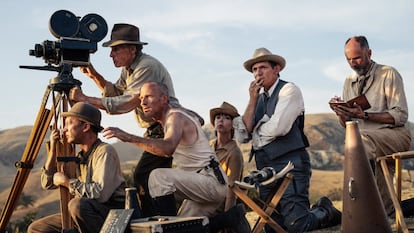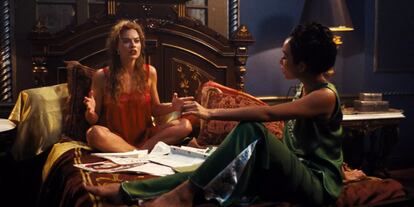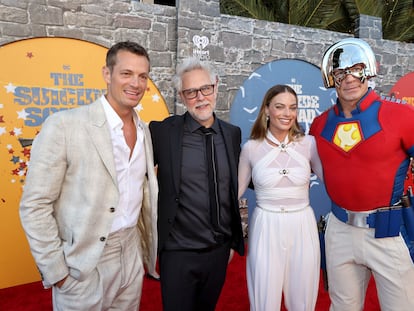‘Babylon:’ A love song to the lawless years of Hollywood
Damien Chazelle’s drama about the late 1920s in the film industry recreates a period of debauchery, art and business, when stars like John Gilbert and Clara Bow disappeared overnight

It was the happiest moment of the 20th century, one with unbounded excess and debauchery. The interwar period of the roaring twenties brought a moment of cultural rebirth in Paris, New York, Chicago, Berlin, Buenos Aires and Los Angeles. The pioneers of cinema had arrived, fleeing Thomas Edison’s patent claims and seeking a place with as many hours of sunshine as possible to shoot movies outdoors. The industry required young bodies, beautiful faces, talented people and tireless work, in exchange for huge profits, fame and glory. On the mountain that borders Los Angeles, the huge Hollywood sign advertised a new development. The studios had flourished at its feet: in the 1920s cinema was already the fifth-largest industry in the United States, but that neighborhood of Los Angeles still was home to empty lots, crops and animals. On the other side of the mountain, in the valley, were the orange groves and the immense estates. In that ecosystem, depravity, art and business came together. Many directors, descendants of the original filmmakers who arrived in California, have paid homage to that moment. The latest is Damien Chazelle with Babylon.
In Babylon, which critics in the United States have not received warmly, the director of La La Land uses almost no real names. The references are so obvious, though, that unmasking them becomes an exercise in film history trivia. The protagonists are a Mexican immigrant eager to prosper, an actress with a wild side who is capable of doing anything for success, and a handsome star who sees the end of his career approaching. It takes place against the backdrop of Hollywood in the late 1920s, when the arrival of sound swept away the established paradigm.

Chazelle has said that he began pre-production of the film by watching a marathon of classic and contemporary cinema surrounded by his collaborators. He screened titles like Intolerance, by D. W. Griffith; Pandora’s Box, by G. W. Pabts, and Wings, by William Wellman, the first film to win an Oscar. Curiously, he does not mention more obvious references: Good Morning, Babylon (1987), by the Taviani brothers, or the sacred text of cinephile gossip, Hollywood Babilonia, which turned its author, the experimental filmmaker Kenneth Anger, into the empire’s designated myth-maker. Chazelle shares with them the biblical reference to Babylon, the city of a thousand languages and a symbol of human ambition, as well as the portrayal of that libidinous era.

Historically, Babylon is just as lax as Hollywood, Ryan Murphy’s Netflix series. Some characters have the advantage of being portrayed by good actors. Jack Conrad, the heartthrob played by Brad Pitt, draws from Rodolfo Valentino, Chazelle says, as well as Douglas Fairbanks, who died in 1939 at the age of 56 without succeeding in sound films, and John Gilbert, who died at the age of 38 in 1936. Pitt and Gilbert’s Conrad share several characteristics: a marriage to a theater actress who despises the cinema, the mustache once obligatory in leading men, the alcoholism and the laughter he provoked while filming his first romantic film with sound. That failure ended his career.

Emerging actress Nelly LaRoy was inspired by Clara Bow, the first “It Girl” in history. Emma Stone was originally cast to play her, but due to the delay caused by Covid, Stone left the project and Margot Robbie took her place. She has further emphasized the character’s animalistic side, without forgetting Bow’s essence, her iron determination to leave her family’s poverty behind and her strange experience with sound (Chazelle steals an anecdote of Bow blowing up the recording system on the set of The Wild Party). Her career’s beginnings, sneaking into a party and stealing the show the next day at her first shoot, is more reminiscent of Joan Crawford. The wild heart, says Chazelle, is born of Hungarian actress Lya De Putti, who fought against the hegemony of Hollywood – and lost. The third protagonist, the Mexican Manny Torres, brilliantly embodied by Diego Calva, is inspired, according to Chazelle, by immigrants like René Cardona, a Cuban who in the 1920s became the youngest executive in Hollywood, and Enrique Vallejo, a Mexican who began in cinema as Chaplin’s cameraman and ended up as a director and head of production. Max Minghella gives life to the only character who appears under his real name, Irving G. Thalberg, the mythical head of Metro-Goldwyn-Mayer, the innovative producer of immense talent, a so-called “wonder boy” who died at the age of 37 at the peak of his career.

Other alter egos appear in camouflage. Jean Smart stars as a gossip columnist with career-destroying power, evoking Hedda Hopper and Louella Parsons. Chazelle points to another reference: Addison De Witt’s character in About Eve. The director who launched the young actress to fame, the filmmaker who discovered the fire in LaRoy’s eyes, is a tribute to Dorothy Arzner (played by Olivia Hamilton, Chazelle’s wife). Spike Jonze, who is uncredited, plays Otto, an outrageous director with a German accent, clearly based on Erich von Stroheim. And in Babylon, the singular actress Lady Fay Zhu, who dances in a tuxedo flirting with men and women alike, reflects the legendary figure of Anna May Wong, the first Chinese-born star in Hollywood. Like her, she is bisexual and lives in her family laundromat, and they both know they don’t fit in with their times.

The industry’s jump to sound sent half of the film industry into obsolescence: stars who did not speak or whose accents were intolerable, who had succeeded only because of their magnetism on the big screen, and creators who floundered amid the cumbersome technical process of sound recording. The 1920s, as Babylon depicts, were times for debauchery. Some careers ended poorly: no comedian was more famous than Roscoe Fatty Arbuckle, who in 1922 was accused in three high-profile trials of the rape and murder of actress Virginia Rappe. He was acquitted due to lack of evidence, but he never worked again.

Arbuckle was the discoverer of Harold Lloyd and mentor of Charlie Chaplin. Curiously, in a city that has not bothered to preserve its iconic buildings, the interiors of the first sequence of Babylon, when an orgiastic dance takes place in a large hall, were filmed at the Ace Theater in downtown Los Angeles, a venue that Chaplin, Mary Pickford, Griffith and Fairbanks created to launch their company, United Artists. The exterior of that mansion, away from everyone and everything, safe from prying eyes, was shot at Shea’s Castle, in the hills of Palmdale, 60 miles from Los Angeles. The castle was erected in the 1920s, commissioned by a businessman named Tommy Lee, who, aware that it took two hours for his guests to get there by car, built a landing strip nearby for flights from Los Angeles. Babylon also includes sequences in the mansion of Busby Berkeley, the filmmaker of great kaleidoscopic musicals, whose home adjoins Arbuckle’s.

Of athat era, little remains: 90% of American silent cinema has disappeared. At the end of Babylon, one of the characters slips into a screening of Singing in the Rain, a masterpiece about that dramatic shift in the industry. As the classic song says, there’s a tear for every smile in Hollywood.
Sign up for our weekly newsletter to get more English-language news coverage from EL PAÍS USA Edition
Tu suscripción se está usando en otro dispositivo
¿Quieres añadir otro usuario a tu suscripción?
Si continúas leyendo en este dispositivo, no se podrá leer en el otro.
FlechaTu suscripción se está usando en otro dispositivo y solo puedes acceder a EL PAÍS desde un dispositivo a la vez.
Si quieres compartir tu cuenta, cambia tu suscripción a la modalidad Premium, así podrás añadir otro usuario. Cada uno accederá con su propia cuenta de email, lo que os permitirá personalizar vuestra experiencia en EL PAÍS.
¿Tienes una suscripción de empresa? Accede aquí para contratar más cuentas.
En el caso de no saber quién está usando tu cuenta, te recomendamos cambiar tu contraseña aquí.
Si decides continuar compartiendo tu cuenta, este mensaje se mostrará en tu dispositivo y en el de la otra persona que está usando tu cuenta de forma indefinida, afectando a tu experiencia de lectura. Puedes consultar aquí los términos y condiciones de la suscripción digital.
More information
Archived In
Últimas noticias
Chris Martin, Taylor Swift, Elijah Wood and other famous wedding ‘crashers’
‘How does it feel to be a failure?’: Elizabeth Berkley’s journey from ‘Showgirls’ ridicule to vindication
The story of the Málaga virus: The code that haunted Google’s cybersecurity center director for 30 years
The impact of Ecuador’s mega-prison: A polluted river, cleared forests and military checkpoints
Most viewed
- Christian Louboutin: ‘Young people don’t want to be like their parents. And if their parents wear sneakers, they’re going to look for something else’
- The low-cost creative revolution: How technology is making art accessible to everyone
- Liset Menéndez de la Prida, neuroscientist: ‘It’s not normal to constantly seek pleasure; it’s important to be bored, to be calm’
- All the effects of gentrification in one corner of Mexico’s Colonia Roma
- December Social Security and SSI payments: Dates, double checks and the 2026 COLA increase











































